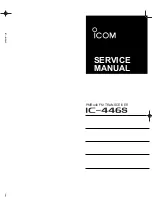
Reference Information
58
Reference Information
Linked Operation with CEC-compatible
Components
The AV receiver is compatible with the following
components (as of January 2014).
TV (Random order):
• Toshiba TV sets
• Sharp TV sets
Players/Recorders (Random order):
• Onkyo and Integra RIHD-compatible players
• Toshiba players and recorders
• Sharp players and recorders (only when used together
with Sharp TV sets)
Models other than those mentioned above may have some
interoperability if compatible with CEC, which is part of the
HDMI Standard, but operation can not be guaranteed.
Note: For RI functions to work properly, do not connect more RIHD-
compatible components than the quantities specified below, to
the HDMI jack. RI functions are not guaranteed when more RIHD-
compatible components than the below mentioned quantities are
connected. Furthermore, do not connect the AV receiver to another
AV receiver/AV amplifier via HDMI.
• Blu-ray Disc/DVD players: up to 3.
• Blu-ray Disc/DVD recorders: up to 3.
• Cable TV tuner, terrestrial digital tuner, and satellite broadcasting
tuner: up to 4 units.
Checking whether the HDMI Linked Operation
Settings Are Enabled
1. Turn on the power of all connected components.
2. Turn off the power of the TV, and confirm that the power
of the connected components is turned off automatically
with the link operation.
3. Turn on the power of the Blu-ray Disc/DVD player/
recorder.
4. Start playback on the Blu-ray Disc/DVD player/recorder,
and verify the following:
• The AV receiver automatically turns on, and selects the
input to which the Blu-ray Disc/DVD player/recorder is
connected.
• The TV automatically turns on, and selects the input
to which the AV receiver is connected.
5. Following the operating instructions of the TV, select
"Use the TV speakers" from the menu screen of the TV,
and confirm that the audio is output from the speakers of
the TV, and not from the speakers connected to the AV
receiver.
6. Select "Use the speakers connected from the AV
receiver" from the menu screen of the TV, and confirm
that the audio is output from the speakers connected to
the AV receiver, and not from the TV speakers.
Note:
• Even if you set to output audio on the TV speakers, audio will
be output from the speakers connected to the AV receiver when
you adjust the volume or switch the input on the AV receiver.
To output audio from the TV speakers, redo the corresponding
operations on the TV.
• In case of an RIHD connection with RI and RI audio control
compatible components, do not connect the RI cable at the
same time.
• On the TV, when you select anything other than the HDMI jack to
which the AV receiver is connected, the input on the AV receiver
will be switched to "TV/CD".
• The AV receiver will automatically power on in conjunction
when it determines it to be necessary. Even if the AV receiver
is connected to an RIHD compatible TV or player/recorder, it
will not power on if it is not necessary. It may not power on in
conjunction when the TV is set to output audio from the TV.
• Linked system functions with the AV receiver may not work
depending on the component model connected. In such cases,
operate the AV receiver directly.
• When the player/recorder cannot be operated with the remote
controller of the AV receiver, the corresponding component may
not be programmed to support the remote controller operation of
CEC. Program the remote control code of the component maker
to the remote controller for using.
About HDMI
HDMI (High Definition Multimedia Interface) is a digital
interface standard for connecting TVs, projectors, Blu-
ray Disc/DVD players, set-top boxes, and other video
components. Until now, several separate video and audio
cables have been required to connect AV components. With
HDMI, a single cable can carry control signals, digital video,
and digital audio (2-channel PCM, multichannel digital
audio, and multichannel PCM).
The HDMI video stream (i.e., video signal) is compatible
with DVI (Digital Visual Interface) (
1), so TVs and displays
with a DVI input can be connected by using an HDMI-to-
DVI adapter cable. (This may not work with some TVs and
displays, resulting in no picture.)
This unit supports HDCP (High-bandwidth Digital Content
Protection) (
2), so it can display picture only on HDCP-
compatible components.
The HDMI on this unit supports the following functions:
Audio Return Channel, 3D, x.v.Color, DeepColor, Lip Sync,
4K (Passthrough), DTS-HD Master Audio, DTS-HD High
Resolution Audio, Dolby TrueHD, Dolby Digital Plus, DSD
and Multichannel PCM.
Supported Audio Formats of this Unit:
• 2-channel linear PCM (32 - 192 kHz, 16/20/24 bit)
• Multichannel linear PCM (up to 7.1 ch, 32 - 192 kHz,
16/20/24 bit)
• Bitstream (DSD, Dolby Digital, Dolby Digital Plus, Dolby
TrueHD, DTS, DTS-HD High Resolution Audio, DTS-HD
Master Audio)
Your Blu-ray Disc/DVD player must also support HDMI
output of the above audio formats.
















































